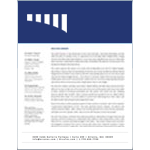
U.S. Economic News
October 25, 2018
U.S. Economic Indicators
New orders of manufactured durable goods rose 0.8% in September after rising 4.6% (revised) in August, and are up 8.9% year to date. Excluding transportation, new orders edged up 0.1% (up 7.7% YTD). Census Bureau Report
The U.S. Census Bureau Advance Economic Indicators Report shows that the goods deficit widened to $76.0 billion in September from $75.5 billion in August. Meanwhile, wholesale inventories rose 0.3% and retail inventories inched up 0.1%. Census Bureau Report
Initial jobless claims rose 5,000 to 215,000 last week. The four-week moving average was unchanged at 211,750. DOL Report
The National Association of Realtors pending home sales index inched up 0.5% in September (down 1.0% Y/Y). NAR continues to point to the lack of inventory of moderately-priced homes as the reason for weak contract activity. NAR Report
U.S. News
Sam Fleming of the Financial Times reports that former Fed chair Janet Yellen is worried about deteriorating lending standards in the market for corporate loans. Yellen also said that there are a lot of weaknesses in the corporate debt market, especially where debt has been repackaged and sold off as financial derivatives. FT